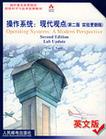操作系统
2002-8-1
人民邮电出版社
Gary Nutt
679
945000
无
本书是一本操作系统课程的学习教材,全书共分十八章。第一至第四章是介绍性内容,是学习操作系统的基础,其中第一章介绍操作系统是什么和操作系统是如何发展到今天的现状的;第二章介绍如何使用操作系统,特别是多进程操作系统;第三章介绍操作系统的基本组织和实现策略;第四章介绍计算机的组织。从第五章开始介绍了操作系统的各个部分,首先在第五章介绍设备管理,特别是基本技术、缓冲区和设备驱动。第六章至第十章介绍进程管理,其中第六章介绍基本的任务概念、进程组织和资源管理;第七章介绍进程调度;第八章介绍基本的同步方法;第九章介绍高层的同步方法;第十章介绍死锁问题。在第十一章介绍了内存管理,第十二章介绍虚拟内存管理,第十三章介绍文件管理,第十四章介绍保护机制和安全策略。第十五章至十七章介绍了支持分布式计算的操作系统技术,其中第十五章介绍网络管理;第十六章介绍远程文件管理;第十七章介绍分布计算,包括分布式进程管理、消息传递机制、远程过程调用和分布式内存管理。最后在第十八章介绍了一些操作系统实例,包括UNIX、Linux、Windows NT、Mac OS和Chorus微内核操作系统。 本书是作为计算机科学和工程类专业教材编写的,也可供有关科技人员参考。
Preface To the Student To the Instructor Chapter1 Introduction 1.1 Computers and Software 1.1.1 General System Software 1.1.2 Resource Abstraction IN THE HANGAR: A Disk Device Abstraction 1.1.3 Resource Sharing 1.1.4 Computers Without System Software 1.2 Operating System Strategies PERFORMANCE TUNING: Multiprogramming Systems 1.2.1 Batch Systems IN THE HANGAR: Batch Files 1.2.2 Timesharing Systems 1.2.3 Personal Computers and Workstations 1.2.4 Process Control and Real-time Systems 1.2.5 Networks 1.2.6 The Genesis of Modern Operating Systems IN THE HANGAR: The Evolution of Linux IN THE HANGAR: The Microsoft Windows Family of Operating Systems 1.3 Summary 1.4 Exercises Chapter2 Using The Operating System 2.1 The Abstract Model of Computing 2.2 Resources 2.2.1 Files IN THE HANGAR: POSIX Files IN THE HANGAR: Windows Files 2.2.2 Other Resources 2.3 Processes 2.3.1 Creating Processes IN THE HANGAR: Using FORK, JOIN, and QUIT IN THE HANGAR: Creating Processes in UNIX IN THE HANGAR: Creating Processes in Windows 2.4 Threads IN THE HANGAR: C Threads 2.5 Objects 2.6 Summary 2.7 Exercises LABORATORY EXERCISE: A Shell Program Background Attacking the Problem LABORATORY EXERCISE: A Multithreaded Windows Console Application Background Attacking the Problem Chapter3 Operating System Organization 3.1 Factors in OS Design 3.1.1 Performance 3.1.2 Protection and Security 3.1.3 Correctness 3.1.4 Maintainability 3.1.5 Commercial Influence on Operating Systems 3.1.6 Standards and Open Systems 3.2 Basic Functions 3.2.1 Device Management 3.2.2 Process and Resource Management 3.2.3 Memory Management 3.2.4 File Management 3.2.5 Functional Organization 3.3 Basic Implementation Considerations 3.3.1 Processor Modes 3.3.2 Kernels 3.3.3 Requesting Services from the Operating Systems 3.4 Summary 3.5 Exercises Chapter4 Computer Organization Chapter5 Device Management Chapter6 Process Management Chapter7 Scheduling Chapter8 Basic Synchronization Principles Chapter9 High-level Synchronization Chapter10 Deadlock Chapter11 Memory Management Chapter12 Virtual Memory Chapter13 File Management Chapter14 Protection and Security Chapter15 Networks Chapter16 Remote Files Chapter17 Distributed Computing Chapter18 Strategies and Examples

无